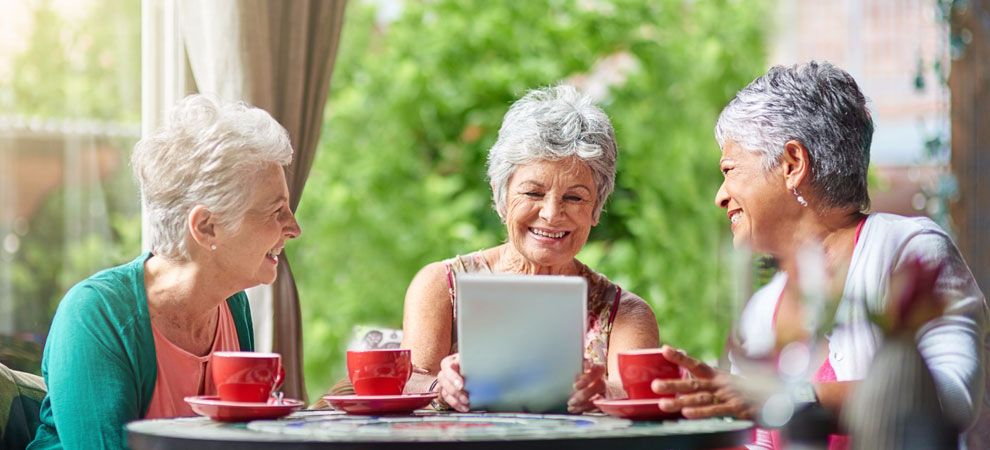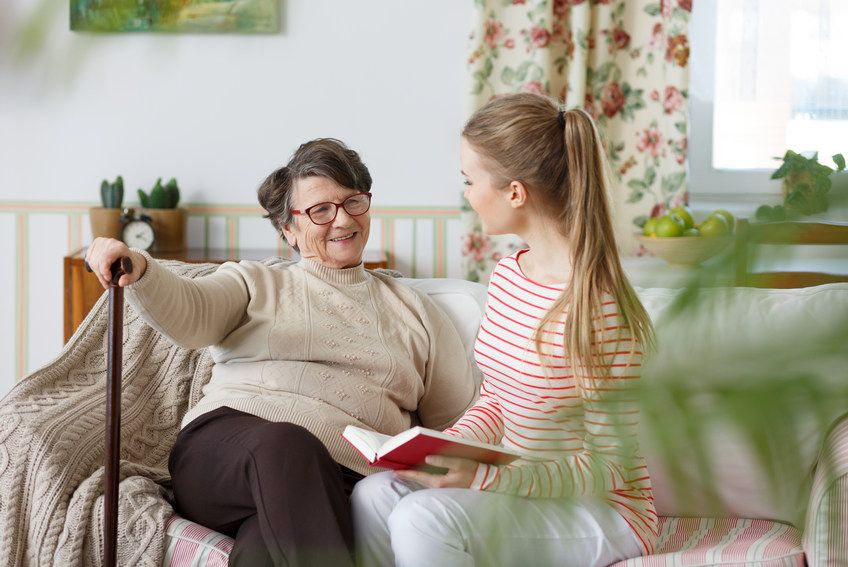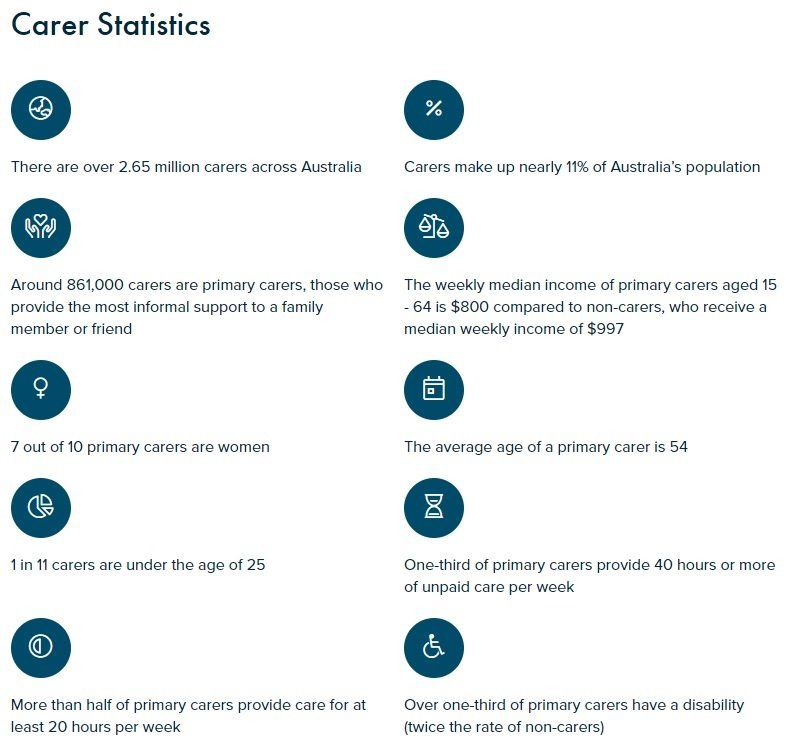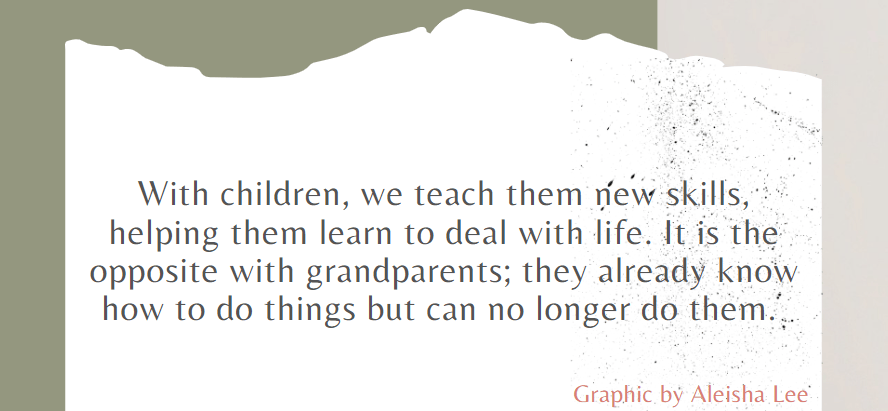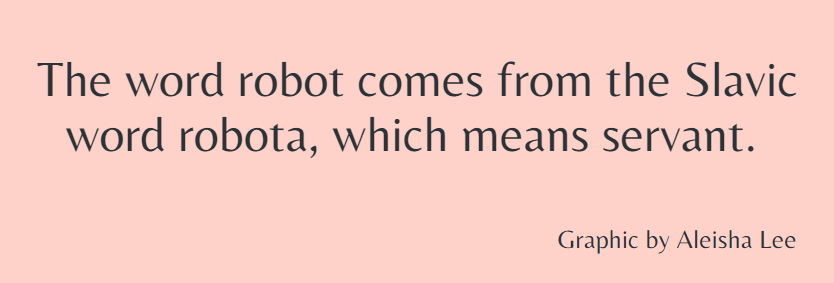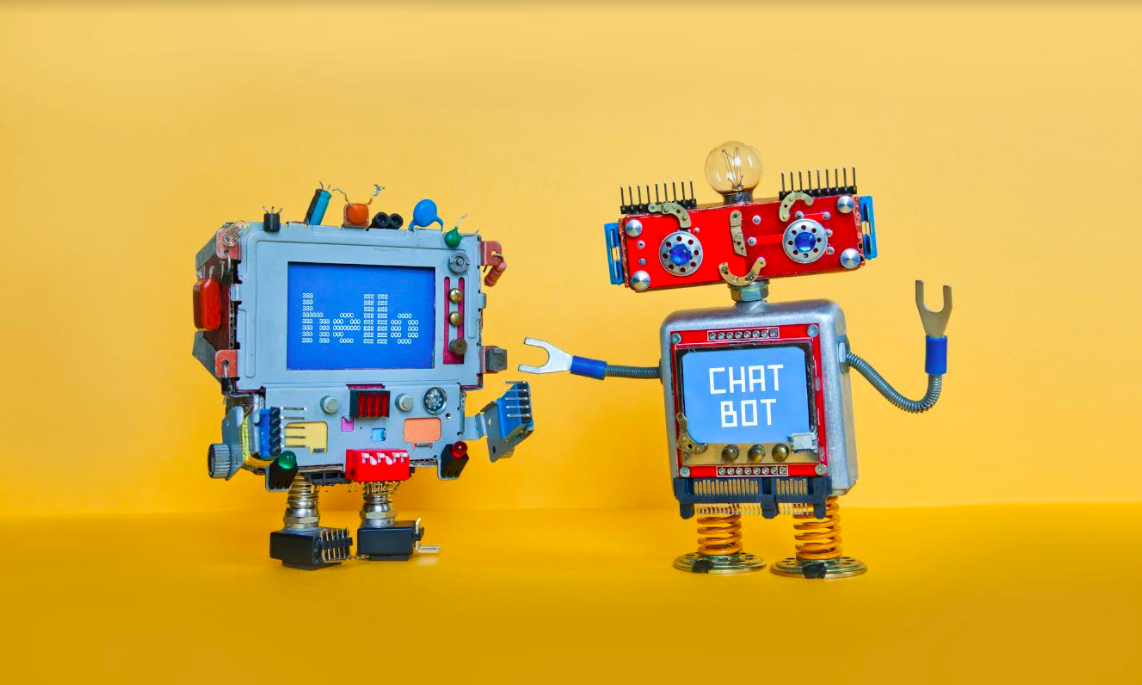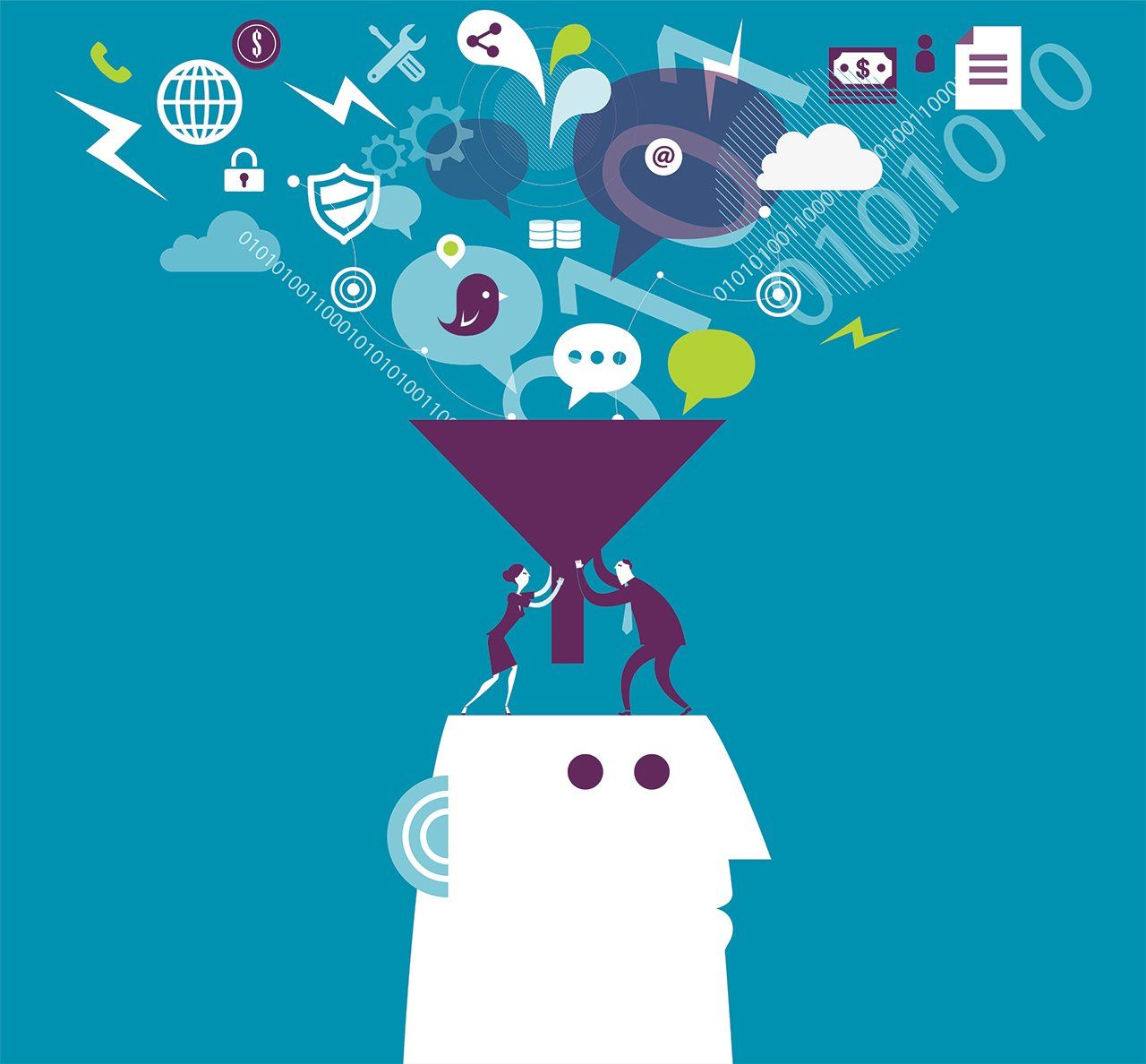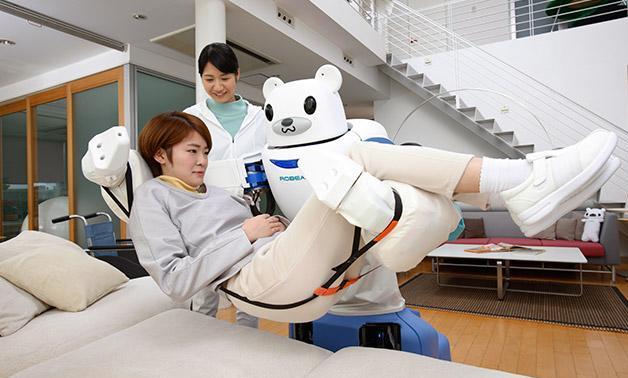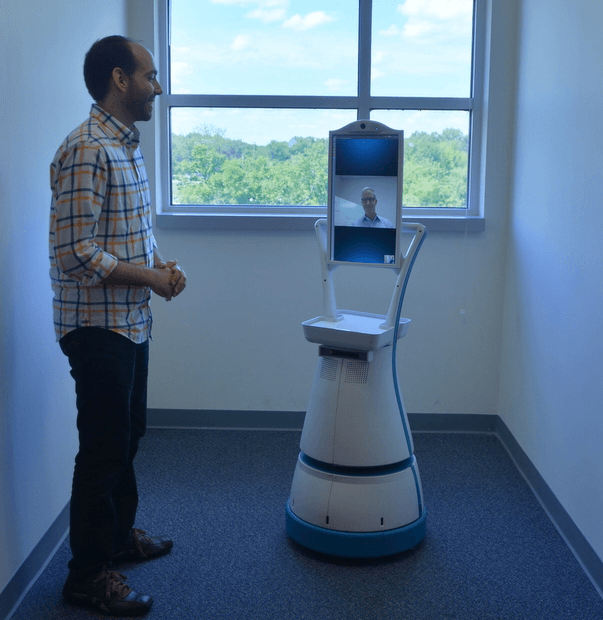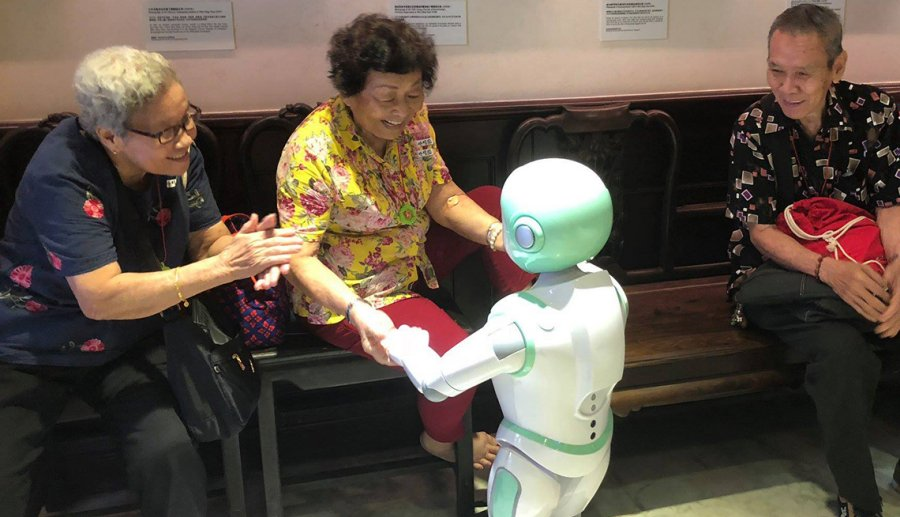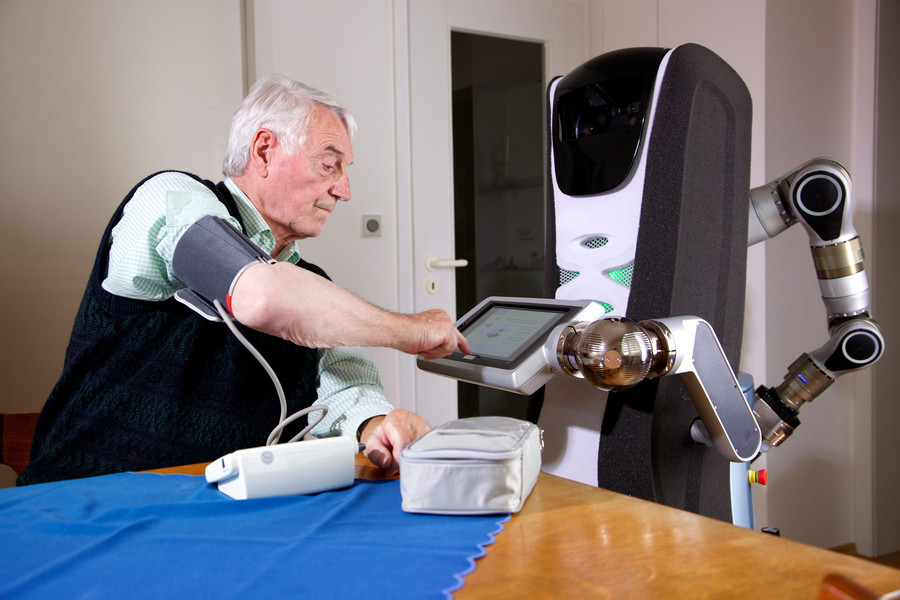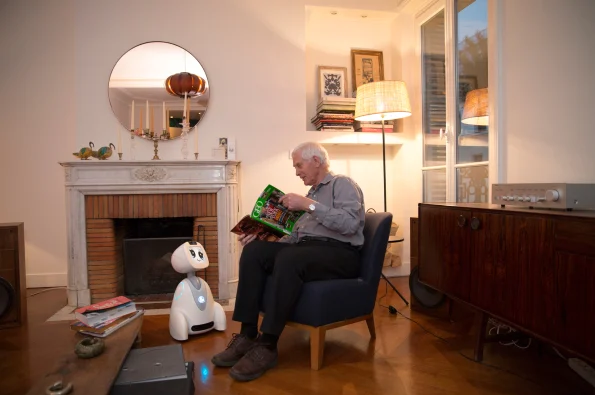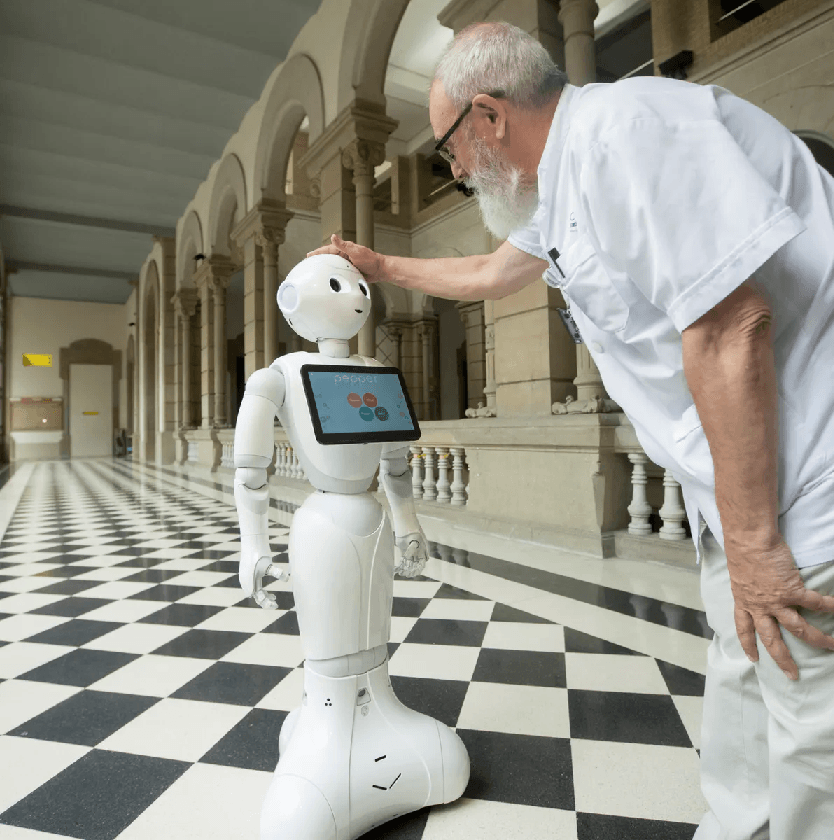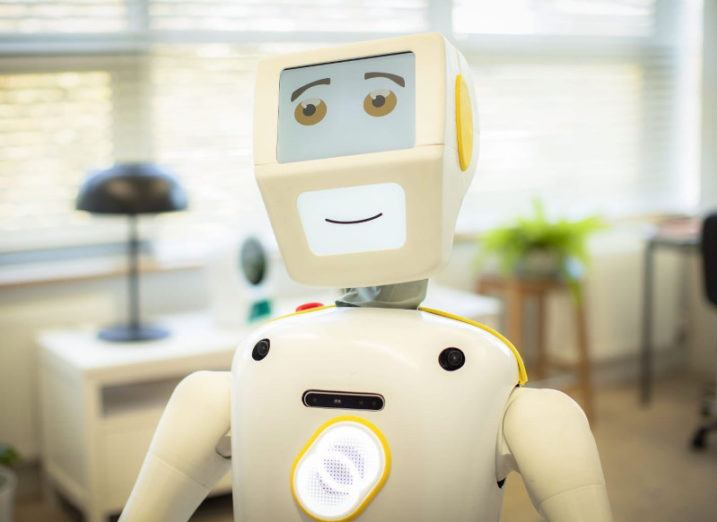nown for bear hugs, affection, smiles, and wisdom, grandparents are special. They tell the best stories, have the answers to everything, not to mention the candy treats. They hold a special place in our hearts. It is such a blessing to have them as part of the family. I credit my Nan and Pop for playing a pivotal role in shaping my beliefs, values, morals, and attitudes. They taught me the Zen of Excellence, which is to enjoy what I am doing in the moment and engage it wholeheartedly. It is a life principle I live by every day. As they grow older, it is our top priority to give back the love they showed us and make sure they are well looked-after, and age happily.
Happy Ageing - the Promise of the AI-Powered Care Bots
Aleisha Lee, CPA
11 July 2021 | < 15 minutes read
Source: Lifeline
A 75-year Harvard study found that
"the secret to longevity and happy life is through connection".
(Mineo, 2017)
As our grandparents grow old, they will find it more and more difficult to create social bonds. Loneliness is a big problem among their generation. Data indicated that
around 10 to 15 per cent of senior Australians are experiencing anxiety and depression, and at least 13 per cent of them over 65 are chronically lonely.
(AIHW, 2019)
Social isolation, depression, helplessness and boredom are also common complaints, with many feeling 'abandoned'. The condition worsens when they also suffer from immobility, cognitive decline and other health issues such as dementia.
A demographic shift
In Australia, research has shown
a significant increase over the past ten years in the prevalence of three-generation households and "grandfamilies", meaning households consisting solely of grandparents and grandchildren.
(Australian Institute of Family Studies, 2015)
Source: Best Home Care
There is a positive correlation between this demographic shift and a remarkable increase of adult grandchildren serving as the primary caregivers for their grandparents. A recent industry report published by Deloitte showed that 26 per cent of informal caregivers are between the ages of 15 and 44 in Australia. (Deloitte Access Economics, 2020)
Millennials, members of Gen X and Gen Y are ageing into the caregiving role for their senior loved ones. Many of us have also lived with or have been raised by our grandparents. We feel close to them and happy to take on the caregiving role simply out of love. Sometimes, we live closer to them than other family members, and it makes sense to contribute to the caregiving role.
Source: ABS
The idea of age-in-place
There is increasing evidence showing the idea of ageing-in-place is gaining popularity. Ageing-in-place is a living arrangement where the elders can remain living in their home and be looked after by a close family member. Studies have shown that seniors overwhelmingly prefer this idea instead of living in an assisted living facility or retirement institution.
A recent study revealed that more than 86 per cent of the Australian population aged 65 and over live at home, and 11 per cent reside in retirement villages and other eldercare institutions. (AIHW, 2019)
Home care arrangement has many obvious benefits which are often absent in retirement facilities, such as comfort and security, social interaction, companionship, compassion, personalised one-on-one care, closer ties to family, and the list goes on. Elders who are ageing-in-place are much happier and have a higher quality of life than those living in retirement facilities.
The juggling act of caregiving
We know that keeping our grandparents at home during their golden years is an admirable gesture and a wonderful thing to do. But in today's fast-paced society, we are often so busy with study, work, children, and day-to-day schedules that visiting them once a week can sometimes be difficult, let alone taking time off to care for them daily. It almost seems like mission impossible. Many grandchildren carers often find themselves having to make life-altering sacrifices for taking care of loved ones.
While much attention has been paid to working parents trying to balance their career with parenthood, grandchildren bearing the burden of eldercare have a very different experience. It is a tough job, unpaid, and often undervalued.
Many may think that looking after grandparents is all about grocery shopping, taking them out for a stroll, or helping them with some life administrative tasks. In reality, family carers pick up the roles of personal chefs, nutritionists, physical therapists, psychologists, patient advocates, and companions. Many of whom are working under incredible stress, financial strains, and a lack of sleep. As a result, they often find that they need to withdraw from social activities, give up on their hobbies, switch to a less demanding job, take time off, or even opt-out altogether to make time for their caregiving duties.
Recent research revealed that in Australia, only 22 per cent of primary carers have full-time employment compared to the population average of 43 per cent. In contrast, part-time employment for primary carers ranged between 29 per cent and 34 per cent, compared with 22 per cent and 23 per cent for the general population. (Deloitte Access Economics, 2020) These statistics show that caregivers often have to sacrifice their own prosperity and put their life on hold to care for those they love.
Source: Semantic Scholar
Embrace the power of Artificial Intelligence (AI) technology
We know that there is nothing better than a hug from our loving grandparents. Giving them a happy elder life without losing ourselves means we have to find ways to do more with less. Today we are already living in an era of unlimited technology. Practically every task in our daily life is tech-driven. For example, those serious coffee drinkers like myself, we can now start our day with the smart coffee maker that cleverly recognizes our daily coffee ritual and sets a timer for our morning brew the night before. And for those who like to hit the snooze button in the morning, the HiCan Smart Bed promises to activate the brain's glymphatic system, recognize the circadian rhythm, and wake us during the lighter sleeping stage to prevent us from waking up cranky and groggy. Technology has undoubtedly made our lives so much more comfortable than ever before.
No longer a fantasy, a computer-controlled future for eldercare has arrived.
For years, Artificial Intelligence (AI) is just a dream for computer scientists and Hollywood sci-fi movie producers. As technological development accelerates and permeates every aspect of our lives, a combination of AI, machine learning, deep learning, and robotics is starting to transform the world of eldercare.
Already on the market is a dazzling array of new AI-driven devices and smart home technologies promising to make day-to-day life simpler for ageing grandparents and family carers.
Imagine having a trusted companion, caregiver, helper, butler and nurse, all in one that you can summon its companionship and service at any time, constantly and tirelessly present, placing our grandparent's welfare at the centre of its attention.
Powered by AI and known as the 'care bots', they are personal robots specifically designed to assist with the activities of daily living and promise to deliver improved quality of life. These evolutionary care bots have eased their way into home care, assisted living and aged-care facilities near us.
Source: Semantic Scholar
The technology behind care bots
The technology behind these smart care bots is the same as any virtual assistant, reliant upon input and intelligent algorithms. Like the chatbots technology, it is a call-and-response with the user giving instructions to the robot, and it will respond with the correct information. Care bots are programmed to reason, learn, comprehend, and react to different situations in different environments.
Care bots often have state-of-the-art navigation, motion sensors, fall detection, voice activation, GPS, bluetooth, cellular connectivity, smartphone monitoring apps, IoMTs, biometric tracking and sophisticated perception technology. They collect many terabytes of data from observing and monitoring our loved ones' everyday activities and their surroundings. Through this complex data mining process, big data is analysed by computer scripts known as algorithms to track activity patterns, predict behaviours, monitor wellness, identify vital signs, and make suggestions about daily living and other leisurely activities.
Source: The Information Age
Like how "Hey Siri" activates Apple devices, care bots respond to voice commands such as "help me", "what's for dinner", "take my temperature", "I'm not well" or "call my granddaughter". They can also recognise gestures and head movements, and detect cough-like motions and body expressions relating to pain.
Care bots come in many different forms and guises.
Some are human-like and can perform minor and repetitive tasks such as fetching food, making juice, turning off lights, picking up items off the floor, and set reminders when it is time to take medications.
Some are delivery robots equipped with autonomous navigation technology that zip around like motorized room service carts. Some are heavy-duty humanoid robots built with powerful hydraulics to help the elders with mobility and transport needs.
For those with mental conditions such as dementia and Alzheimer's disease, there are pet-style and doll-like care bots designed to improve the mood, soothe agitation, and alleviate some of the symptoms.
Apart from their functional capabilities to improve safety and provide care, care bots are becoming increasingly human-like in their appearance and behaviour to
eliminate the negative feelings of eeriness, danger, and threat. They often have joyful names such as Stevie, Lovot, KiKi, Paro, Woobo, Robear, Pillo, and so on, to trigger a soothing and heartwarming psychological effect on the elders.
Meet the top 10 most loved care bots
ElliQ by Intuition Robotics
Source; elliq.com
ElliQ is an aging companion designed to keep elders active, independent, and engaged. Named after the Norse goddess representing old age, ElliQ does not have a face, arms or legs, but she is a tabletop that illuminates when you call her and talks while keeping the elders active. The robot imitates user-to-user head motions. She can look up and be excited. She also answers her phone, reads emails, and plays music.
Besides wellness and environmental monitoring, ElliQ uses machine learning and computer vision to provide proactive suggestions, entertainment, and activities.
ElliQ can remind elders to take their medicines, recall their appointments and prompt suggestions relevant to the current schedule. Elders can play games, access social media, and conduct on-screen video chats to stay connected to the outside world.
Robear
by Riken
Source: Riken.jp
Robear
is a strong robot with a gentle touch that can do tasks such as lifting a patient from a bed in a wheelchair, supporting a standing patient but needing help maintaining balance, and other heavy lifting duties. Weighing just 140 kilograms, Robear is like a
giant, gentle, cartoon-shaped bear, hence the name Robear. It has actuators with a meagre gear ratio, which enables joints to move very fast and accurately. It also includes torque sensors and tactile rubber-type capability sensors that allow gentle movement and ensures that the robot carries out power-intensive tasks such as lifting patients without jeopardising them.
Sam
by Luvozo
Source: Luvozo.com
Sam is a robot companion that enhances the quality of life for elderly and disabled people. This daily companion aims to prevent the isolation of older people and to prevent them from falling. Sam is a human-sized, smiling robot that combines state-of-the-art technology to provide elders with frequent inspection and non-medical care. Sam enables carers to guarantee remote monitoring, physical safety, and communication with loved ones.
The robot has a display and cameras that carers can use to track and make sure they are in good shape visually. It also has sensors and SAM Fall Assessment System software, which allow him to move, thus
preventing falls by identifying the pitfalls.
Zora
by RobotLAB
Source: Robotlab.com
Zora
is an interactive caregiving robot who joins elders in aerobics and singing, playing games and reading. Zora weighs only 5.7 kg and is just over 57 cm. While Zora is small, she speaks an impressive 19 languages. Controlled via tablet, Zora can lead a physical therapy class, read TV shows, weather forecasts, or local news. It can also keep elders entertained and active with dance and exercise.
iPal by AvatarMind
Source: ipalrobot.com
iPal
is a humanoid robot designed to serve the elderly as social companions, educators, and safety monitors. This mobile robot has legs mounted on wheels to move around the home. It can sing, dance, and chat. It has a wide range of motion in its arms and neck, built-in obstacle avoidance software, and a low gravity centre that increases its stability. iPal is 106 cm tall, weighing just over 12 kilos, and comes with a built-in camera, five microphones, and WiFi / Bluetooth capabilities.
Care-O-Bot by Fraunhofer IPA and Mojin Robotics
Source: care-o-bot.de
Care-O-Bot is a mobile robot assistant to help the elderly in their daily lives, providing health care, companionship, and cognitive stimulation. It has a vaguely humanoid shape with a round head, arms, hands, trays and a rolling base. It can perform a range of household tasks such as delivering food, drinks, and medications to the patient and assisting in cooking and cleaning. It can place emergency calls, host video conferences, and engage in conversations.
Care-O-Bot
features a
touch screen, microphones, and speakers for multimodal user input.
Face cameras allow it to adjust its behaviour based on gesture and user interface recognition. It can speak through
LEDs, sounds, speech-to-speech, laser, and body gestures.
Buddy
by Blue Frog Robotics
Source: bluefrogrobotics.com
Designed to be a great emotional companion, Buddy can secure, assist, connect, and entertain the elderly at home. Buddy has a small, dome-shaped body on a fully mobile platform with three wheels. Its oblong face is full of cartoonish emotions. Buddy provides a range of services, including home protection, social interaction, personal support, multimedia, entertainment, calendar reminders, and interactive interfaces. Buddy also has speech recognition software; home and object detection, recognition, and tracking capabilities.
Buddy can
detect falls or unusual events and alert emergency services. It offers mobile telepresence, including Skype and Facetime connections, photo and video sharing, and social media connections. It can set reminders, alarm clocks, and to-do lists and provide practical information such as weather forecasts, recipes, and traffic. It can be a storyteller or an interactive teacher.
Paro
by AIST
Source: aist.go.jp
Paro
is a lifelike robotic seal with long eyelashes and big black eyes that open, close, and follow movements.
Paro is the size of a large cat, and weighs nearly 3kg. It charges by an oral electric dummy and has sensors that detect touch, sound, light, heat, and movements. Paro also reacts to changes in the elder's mood, physical touch and recognises its own name.
Pepper by Softbank
Source: softbankrobotics.com
Pepper is the humanoid robot that provides day-to-day companionship and support in everyday tasks. Pepper is capable of recognising human emotions, such as joy, sadness, anger and surprise. Using its cameras located in its head, Pepper can interpret a smile, frown, tone of voice, verbal and body language. Pepper can also engage in basic conversations, but the conversational capability is far from perfect and needs further development.
If it doesn't understand a question, it spits out a bunch of silly answers such as,
'I don't understand, how about a taco?', 'I can barely keep up with you in this conversation, but I think you are hot.'
Stevie by Robotics and Innovation Lab
Source: siliconrepublic.com
Stevie is what's known as the joke-telling and socially assistive robot. It is designed to be engaging physically and mentally. The 140 cm robot comes with autonomous navigation. It can roll through the home unassisted. The voice command "Hey Stevie" activates the robot, similar to "Hey Siri".
Stevie responds to other words with speech, gestures, and head movements. Tell him that you're sick, for example, and it slumps forward with a sorrowful frown on its LED-screen face and says, "I'm sorry to hear that." Pay Stevie a compliment, and the screen reverts to a smile. When at rest, its head tilts gently, and its digital brown eyes blink, patiently waiting for the next command.
Stevie's face can double as a video-conferencing screen, enabling the user to video chat with a doctor or loved ones. Other functions could be the difference between
life and death.
The robot can recognise voice commands such as "help me", and alert the carer to the elder in distress.
The eldercare robots are far from perfect, and much of the current robotic applications are still primarily focused on improving efficiency and enhancing quality and safety. Although concerns have been expressed about robots potentially reducing privacy, exposing people to data hacking, or even inflicting physical harm, it sure can help alleviate many stresses faced by family carers.
Some final thoughts
Age catches up with all of us, and there is no way of escaping it. We are so busy growing up, and we often forget our grandparents are also growing old. After caring for their children and grandchildren, receiving some love back in old age seems like natural justice. It reminds me of the Zulu-sung song 'Circle of Life' in the Disney Lion King movie. The song in its entirety is about young prince Simba's life journey from birth to adulthood through connection, love, loss, misfortune, the union with Nala, and the birth of their new cub on Pride lands.
I couldn't help but think that the 'Circle of Life' plays itself out in many families' everyday lives across the world, regardless of race, nationalities, or religious beliefs. Our family and our lives are part of a continuous life cycle, a connected continual process from birth to death that goes on ad infinitum.
At times our lives can be unbearably difficult, having to deal with many life stressors such as ill-health, depression, financial strains, relationship struggles, and so much more. Caregiving for the young and elderly is an inevitable part of human existence. As we get older, so do our grandparents. They will need our help, just as we once needed theirs.
Source: disney.fandom.com
Care bots will not replace human carers, just like computers didn't replace humans, rather, it is making ageing in place a much more viable and attractive option.
As emotion AI and brain-control technology continue to improve and develop, the best is yet to come. Perhaps in the not-so-distant future, care bots will have a built-in neural network that mimics the human brain. They will be able to not only think but also feel and behave like us. Then they can perform all kinds of customised care services and do almost everything we human can.
In my opinion, robots will always remain robots. They can appear empathic and helpful, but they are just machines. There is no amount of robotic neural technology or machine empathy that can replace the warmth, love and humanly touch from family. Caregiving is tough. But one day, we will want to look back, knowing that we did our best to give our loved ones a good journey and the best possible quality of life throughout their golden years. For me, joys and struggles aside, it is, without doubt, worth every bit of hard work and personal sacrifice.
References
https://news.harvard.edu/gazette/story/2017/04/over-nearly-80-years-harvard-study-has-been-showing-how-to-live-a-healthy-and-happy-life/
https://www.aihw.gov.au/reports/older-people/older-australia-at-a-glance/contents/service-use/mental-health
https://growingupinaustralia.gov.au/sites/default/files/publication-documents/asr2015b.pdf
Disclaimer
This article is for general informational purposes only. I give no warranty and accept no responsibility or liability for the accuracy or the completeness of the information and materials contained in this article and on this website. Under no circumstances will I be held responsible or liable in any way for any claims, damages, losses, expenses, costs or liabilities whatsoever (including, without limitation, any direct or indirect damages for loss of profits, business interruption or loss of information) resulting or arising directly or indirectly from your use of or inability to use this website or any websites linked to it, or from your reliance on the information and material in this article and on this website.







